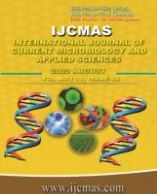


 National Academy of Agricultural Sciences (NAAS)
National Academy of Agricultural Sciences (NAAS)

|
PRINT ISSN : 2319-7692
Online ISSN : 2319-7706 Issues : 12 per year Publisher : Excellent Publishers Email : editorijcmas@gmail.com / submit@ijcmas.com Editor-in-chief: Dr.M.Prakash Index Copernicus ICV 2018: 95.39 NAAS RATING 2020: 5.38 |
Isolation of total 18 bacterial strains were carried out from the decayed wood samples collected from farm of MCRS, NAU, Surat and Surat Municipal Waste site at Khajod, Surat on nutrient agar plates. Among 18 isolates, four cellulose degrading bacterial strains (CDB) viz., CDB9 (4.0), CDB5 (3.0), CDB15 (3.0) and CDB18 (2.0) showed significant cellulolytic index on Carboxymethyl Cellulose (CMC) agar plate within 48 hrs after flooding with congo red stain. Further, CDB9, CDB5, CDB15 and CDB18 were studied to determine the quantitative cellulose degradation activity in CMC broth and examined for thier FPase and CMCase activity. Maximum FPase and CMCase activity observed with CDB9 (FPase: 0.72 FPU ml-1, CMCase: 1.28 IU ml-1) followed by CDB15 (FPase: 0.50 FPU ml-1, CMCase : 0.78 IU ml-1), CDB5 (FPase : 0.15 FPU ml-1, CMCase : 0.27 IU ml-1) and CDB18 (FPase : 0.002 FPU ml-1, CMCase : 0.008 IU ml-1) at 48 hrs in static condition. Based on quantitative assay, CDB9 and CDB 15 were selected to study biodegradation of cotton stalk. CDB9 isolate showed significant FPase (2.79 FPU ml-1) and CMCase (3.20 IU ml-1) activities with 17 % weight loss of cotton stalk within 30 days than CDB15 (FPase: 0.30 FPU ml-1), CMCase:: 2.30 IU ml-1 and 11 % weight loss); while decreased cellulose amount was observed with both the strains (CDB9: 35.67 mg/ml, CDB15 : 40.27mg/ml). Thus, CDB9 was found to be a remarkable cotton stalk degrader. On the basis of qualitative plate assay for extracellular enzymes production and antibiotic disc assay, it was found CDB9 was able to produce lipase and inhibited by the antibiotics viz., Ampicillin, Amoxyclav, Cefotaxime, Co-Trimoxazole, Gentamicin and Tobramycin within 24 hrs, respectively. On the basis of 16S-rDNA sequencing, CDB9 bacterial strain was identified as Kosakonia oryziphila.
 |
 |
 |
 |
 |